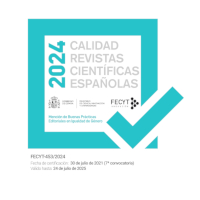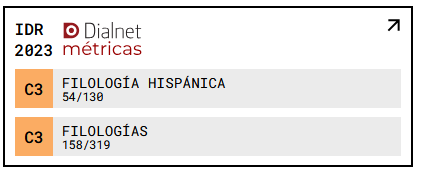Actividades para el aprendizaje del Inglés como Lengua Extranjera en libros de texto de primaria
DOI:
https://doi.org/10.18172/cif.3643Palabras clave:
Escuela Primaria, Inglés como Lengua Extranjera, potencial de enseñanza explícita e implícita, corpus de actividadesResumen
Alcanzar la fluidez necesaria en las destrezas orales y escritas es una de las metas más importantes para los aprendices de Inglés como Lengua Extranjera (ILE). Las distintas actividades presentes en los libros de texto pueden tener diferentes potenciales de enseñanza explícita e implícita según el tipo de conocimiento que promuevan. Por tanto, el tipo de conocimiento que los aprendices logran va a depender, en gran medida, del énfasis que los profesores pongan en las distintas actividades. Dado que los aprendices jóvenes tienden a beneficiarse más de las actividades de carácter comunicativo, el presente estudio exploratorio tiene como objetivo examinar el potencial explícito e implícito de una muestra de 1.952 actividades extraídas de 10 libros de texto de primaria para la Enseñanza del ILE en España. Los resultados mostraron que la proporción de actividades dedicadas a la enseñanza de las formas es más elevada de lo esperable.Descargas
Citas
AGUSTÍN-LLACH, M. (2015). “Age and type of instruction (CLIL vs. traditional EFL) in lexical development”. International Journal of English Studies 16 (1): 75-96. DOI: https://doi.org/10.6018/ijes/2016/1/220691
ALCÓN-SOLER, EVA y GARCIA-MAYO, M. (2008). “Incidental focus on form and learning outcomes with young foreign language classroom learners” en Second Language Acquisition and the Younger Learner: Child’s Play? (Eds. Jenefer Philp, Rhonda Oliver y Alison Mackey). Amsterdam: John Benjamins, 173-192. DOI: https://doi.org/10.1075/lllt.23.12sol
ALIZADEH, K. (2011). “The advantages of active English teaching, emphasizing at active teaching to EFL child students”. Modern Journal of Language Teaching Methods 1 (1): 80-87.
AZKARAI, A. y IMAZ-AGIRRE, A. (2015). “Negotiation of meaning strategies in child EFL mainstream and CLIL settings”. TESOL Quarterly 50 (4): 844-870. DOI: https://doi.org/10.1002/tesq.249
AZKARAI, A. y OLIVER, R. (2016). “Negative feedback on task repetition: ESL vs. EFL child settings”. The Language Learning Journal 1-12. https://doi.org/10.1080/09571736.2016.1196385. DOI: https://doi.org/10.1080/09571736.2016.1196385
BAARS, B. (1997). “In the Theatre of Consciousness: The Workspace of the Mind”. Journal of Consciousness Studies 4 (4): 292-309.
BARRERAS, M. A. (2004). “Vocabulario y edad: Pautas para su enseñanza en las clases de inglés de educación primaria”. Aula Abierta 84: 63-84.
BIALYSTOK, E. (2001). “Metalinguistic aspects of bilingual processing”. Annual Review of Applied Linguistics 21 (1): 169-181. DOI: https://doi.org/10.1017/S0267190501000101
BIALYSTOK, E. (2007). “Cognitive complexity and attentional control in the bilingual mind”. Child Development 70 (3): 636-644. DOI: https://doi.org/10.1111/1467-8624.00046
BIALYSTOK, E., MARTIN, M. y VISWANATHAN, M. (2005). “Bilingualism across the lifespan: The rise and fall of inhibitory control”. International Journal of Bilingualism, 9 (1): 103-119. DOI: https://doi.org/10.1177/13670069050090010701
BREWSTER, J., ELLIS, G. y GIRARD, D. (2002). The Primary English Teacher's Guide. Harmondsworth: Penguin
CAMERON, L. (2001). Teaching Languages to Young Learners. Cambridge: Cambridge University Press. DOI: https://doi.org/10.1017/CBO9780511733109
CAROL, R. y SOBERÓN, A. (2004). Bugs 1 (Student Book). London: Macmillan.
CAROL, R. y SOBERÓN, A. (2004). Bugs 2 (Student Book). London: Macmillan.
CAROL, R. y SOBERÓN, A. (2005). Bugs 5 (Student Book). London: Macmillan.
CAROL, R. y SOBERÓN, A. (2009). Bugs World 2 (Student Book). London: Macmillan.
CEKAITE, A. (2008). “Developing conversational skills in a second language. Language learning affordances in a multiparty classroom setting” en Second Language Acquisition and the Younger Learner: Child’s Play? (Eds. Jenefer Philp, Rhonda Oliver y Alison Mackey). Amsterdam: John Benjamins, 105-129. DOI: https://doi.org/10.1075/lllt.23.08cek
CHARRINGTON, M., COVILL, C. y SHIPTON, P. (2014). Great Explorers 2 (Workbook). Oxford: Oxford University Press.
CORBETT, J. y O'FARRELL, R. (2011). Quest 2 (Student Book). London: Macmillan.
CORBETT, J. y O'FARRELL, R. (2011). Quest 3 (Workbook). London: Macmillan.
CORBETT, J. y O'FARRELL, R. (2012). Quest 4 (Workbook). London: Macmillan.
COUNCIL OF EUROPE. (2001). Common European framework of reference for languages: learning, teaching, assessment. Cambridge: Cambridge University Press.
COVILL, C., CHARRINGTON, M. y SHIPTON, P. (2011). Explorers 2 (Workbook). Oxford: Oxford University Press.
CRIADO, R. (2010). “The Impact of Activity Sequencing on the Differences between ELT Methods: A Critical Analysis of Sample Units”. Porta Linguarum 14 (1): 7-28.
CRIADO, R. y SÁNCHEZ, A. (2009). “The Universal Character of the DEC−>PRO Cognitive Sequence in Language Learning and Teaching Materials”. Revista Española de Lingüística Aplicada (RESLA) 22, 89-106.
CRIADO, R., SÁNCHEZ, A. y CANTOS, P. (2010). “An Attempt to Elaborate a Construct to Measure the Degree of Explicitness and Implicitness in ELT Materials”. International Journal of English Studies 10 (1): 103-129. DOI: https://doi.org/10.6018/ijes/2010/1/114001
DEKEYSER, R. (2015). “Skill Acquisition Theory” en Theories in Second Language Acquisition (Eds. Bill VanPatten y Jessica Williams). Nueva York: Routledge, 94-112.
DEKEYSER, R. y CRIADO, R. (2013). “Automatization, Skill Acquisition, and Practice in Second Language Acquisition” en The Encyclopedia of Applied Linguistics (Ed. Carol A. Chapelle). Oxford: Wiley Blackwell, 1-5. https://doi.org/10.1002/9781405198431.wbeal0067. DOI: https://doi.org/10.1002/9781405198431.wbeal0067
EBBELS, S. (2007). “Teaching grammar to school-aged children with specific language impairment using Shape Coding”. Child Language Teaching and Therapy 23 (1): 67-93. DOI: https://doi.org/10.1191/0265659007072143
ELLIS, R. (2009). Implicit and Explicit Knowledge in Second Language Learning, Testing and Teaching. Bristol: Multilingual Matters. DOI: https://doi.org/10.21832/9781847691767-004
ELLIS, R. (2015). “Form-focused instruction and the measurement of implicit and explicit L2 knowledge” en Implicit and Explicit Learning of Languages (Ed. Patrick Rebuschat). Amsterdam: John Benjamins, 417-442. DOI: https://doi.org/10.1075/sibil.48.17ell
ESCRIBANO, T. y VENTOSA, R. (2006). Sunshine (Student Book). Harlow: Pearson Longman.
ESCRIBANO, T. y VENTOSA, R. (2006). Sunshine (Workbook). Harlow: Pearson Longman.
ESPAÑA. Real Decreto-ley 126/2014, de 28 de febrero, por el que se establece el currículo básico de la Educación Primaria [Internet]. Boletín Oficial del Estado, 1 de marzo de 2014, núm. 52, pp. 2014 a 2222. <https://www.boe.es/buscar/pdf/2014/BOE-A-2014-2222-consolidado.pdf> (Acceso 18 noviembre 2018).
EVANS, S., SHIPTON, P. y TORRES, S. (2014). Great Explorers 4 (Workbook). Oxford: Oxford University Press.
FREEMAN, D. (1989). “Teacher training, development and decision making: A model of teaching and related strategies for language teacher education”. TESOL Quarterly 23 (1): 27-45. DOI: https://doi.org/10.2307/3587506
GOLDSTEIN, B. y JONES, C. (2015). Smart Planet 1 (Student Book). Cambridge: Cambridge University Press.
GOO, J., GRANENA, G., YILMAZ, Y. y NOVELLA, M. (2015). “Implicit and explicit instruction in L2 learning: Norris y Ortega (2000) revisited and updated” en Implicit and Explicit Learning of Languages (Ed. Patrick Rebuschat). Amsterdam: John Benjamins, 443-482. DOI: https://doi.org/10.1075/sibil.48.18goo
GOORHUIS-BROUWER, S. y DE BOT. K. (2010). “Impact of early English language teaching on L1 and L2 development in children in Dutch schools”. International Journal of Bilingualism 14 (3): 289-302. DOI: https://doi.org/10.1177/1367006910367846
GRIS-ROCA, J. (2015). “Categorization of activities used in English as a foreign language: A corpus based study with pedagogical materials”. Procedia - Social and Behavioural Sciences 198: 165-173. DOI: https://doi.org/10.1016/j.sbspro.2015.07.433
GRIS-ROCA, J. (2017). “Grammar in primary school EFL textbook activities: A corpus-driven study of their teaching nature and related cognitive implications”. Research in Corpus Linguistics 5(1): 57-72. DOI: https://doi.org/10.32714/ricl.05.05
HALLIWELL, S. (2000). Teaching English in the Primary Classroom. New York: Longman.
HEARN, I., y GARCÉS-RODRÍGUEZ, A. (2003). Didáctica del inglés para Primaria. Madrid: Pearson Educación.
HOUSE, S. (2011). Didáctica del inglés. Classroom Practice. Barcelona: Graó.
HULSTIJN, J. (2002). “Towards a unified account of the representation, processing and acquisition of second language knowledge”. Second Language Research 18: 193-223. DOI: https://doi.org/10.1191/0267658302sr207oa
HULSTIJN, J. (2005). “Theoretical and Empirical Issues in the Study of Implicit and Explicit Second-language Learning”. Studies in Second Language Acquisition 27: 129-140. DOI: https://doi.org/10.1017/S0272263105050084
KANG, D. (2008). “The classroom language use of a Korean elementary school teacher: Another look at TETE”. System 36: 214-226. DOI: https://doi.org/10.1016/j.system.2007.10.005
KELLY, C. 2017. “The brain studies boom: Using neuroscience in ESL/EFL teacher training” en Innovative Practices in Language Teacher Education (Eds. Tammy Gregersen y Peter D. Maclntyre). Berlin: Springer, 79-99. DOI: https://doi.org/10.1007/978-3-319-51789-6_5
LÁZARO-IBARROLA, A. y AZPILICUETA-MARTÍNEZ, R. (2014). “Investigating negotiation of meaning in EFL children with very low levels of proficiency”. International Journal of English Studies 15 (1): 1-21. DOI: https://doi.org/10.6018/ijes/2015/1/203751
LEOW, R. (2015). Explicit Learning in the L2 Classroom: A Student-Centered Approach. Nueva York, NY: Routledge. DOI: https://doi.org/10.4324/9781315887074
MALPAS, S. (2012). Islands 2 (Student Book). London: Pearson.
MALPAS, S. (2012). Islands 2 (Workbook). London: Pearson.
MOHAMED, S. (2013). Big Surprise 6 (Workbook). Oxford: Oxford University Press.
MONTIJANO-CABRERA, M. (2014). Textbook use training in EFL teacher education. Ultrecht Studies in Language and Communication 27: 267-286. DOI: https://doi.org/10.1163/9789401210485_016
ORMEROD, M. y SHAW, D. (2007). Find Out 3 (Student Book). London: Macmillan.
ORMEROD, M. y SHAW, D. (2007). Find Out 3 (Workbook). London: Macmillan.
PAPIOL, E. y TOTH, M. (2005). Bugs 6 (Workbook). London: Macmillan.
PARADIS, M. (2009). Declarative and Procedural Determinants of Second Languages. Amsterdam: John Benjamins. DOI: https://doi.org/10.1075/sibil.40
PÉREZ, P. y ROIG, V. (2004). Enseñar y Aprender inglés en educación infantil y primaria. Barcelona: Horsori Editorial.
PHILLIPS, S. y REDPATH, P (2008). Incredible English 5 (Student Book). Oxford: Oxford University Press.
PHILLIPS, S. y REDPATH, P (2008). Incredible English 5 (Workbook). Oxford: Oxford University Press.
PHILLIPS, S. y SHIPTON, P. (2011). Explorers 5 (Student Book). Oxford: Oxford University Press.
PHILLIPS, S. y SHIPTON, P. (2014). Great Explorers 6 (Workbook). Oxford: Oxford University Press.
PHILLIPS, S. y SHIPTON, P. (2014). Oxford Rooftops 3 (Workbook). Oxford: Oxford University Press.
PHILLIPS, S. y SHIPTON, P. (2015). Great Explorers 6 (Student Book). Oxford: Oxford University Press.
PHILP, J., OLIVER, R. y MACKEY, A. (2008). Second Language Acquisition and the Younger Learner: Child’s Play? Amsterdam: John Benjamins. DOI: https://doi.org/10.1075/lllt.23
READ, C. (2007). 500 Activities for the Primary Classroom. Oxford: Macmillan. DOI: https://doi.org/10.1093/elt/ccn032
READ, C. (2009). Footprints 3 (Student Book). London: Macmillan.
READ, C. (2009). Footprints 3 (Workbook). London: Macmillan.
READ, C. (2009). Footprints 4 (Student Book). London: Macmillan.
READ, C. (2009). Footprints 4 (Workbook). London: Macmillan.
READ, C., y ORMEROD, M. (2013). Team Tiger 4 (Workbook). London: Macmillan.
REBUSCHAT, P. (2015). Implicit and Explicit Learning of Languages. Amsterdam: John Benjamins. DOI: https://doi.org/10.1075/sibil.48
REILLY, V. (2013). Big Surprise 5 (Student Book). Oxford: Oxford University Press.
SÁNCHEZ, A. (2009). La enseñanza de idiomas en los últimos cien años. Madrid: SGEL.
SCOTT, W. y YTREBERG, L. (1990). Teaching English to Children. London y Nueva York: Longman.
SHAW, D. y ORMEROD, M. (2007). Find Out 2 (Workbook). London: Macmillan.
SHAW, D. y RAMSDEN, J. (2014). High Five! 1 (Workbook). London: Macmillan.
VAN DEN BRANDEN, K. (2008). “Negotiation of meaning in the classroom. Does it enhance reading comprehension?” en Second Language Acquisition and the Younger Learner. Child's Play? (Eds. Jenefer Philp, Rhonda Oliver y Alison Mackey). Amsterdam: John Benjamins, 149-169. DOI: https://doi.org/10.1075/lllt.23.10van
WHITE, J. (2008). “Speeding up acquisition of his and her: Explicit L1/L2 contrasts help” en Second Language Acquisition and the Younger Learner. Child's Play? (Eds. Jenefer Philp, Rhonda Oliver y Alison Mackey). Amsterdam: John Benjamins, 193-228. DOI: https://doi.org/10.1075/lllt.23.13whi
WORRALL, A. (2004). English Adventure 3 (Student Book). Harlow: Pearson Longman.
WORRALL, A. (2004). English Adventure 3 (Workbook). Harlow: Pearson Longman.
WRIGHT, L. (2008). “Home-school connections for international adoptees: repetition in parent-child interaction” en Second Language Acquisition and the Younger Learner. Child's Play? (Eds. Jenefer Philp, Rhonda Oliver y Alison Mackey). Amsterdam: John Benjamins, 279-301. DOI: https://doi.org/10.1075/lllt.23.17fog
ZANATTA, T. (2007). Mega Zoom 3 (Student Book). London: Richmond Publishing.
Descargas
Publicado
Cómo citar
Número
Sección
Licencia
El autor o autora conserva todos los derechos sobre su artículo y cede a la revista el derecho de la primera publicación, no siendo necesaria la autorización de la revista para su difusión una vez publicado. Una vez publicada la versión del editor el autor está obligado a hacer referencia a ella en las versiones archivadas en los repositorios personales o institucionales.
El artículo se publicará con una licencia Creative Commons de Atribución, que permite a terceros utilizar lo publicado siempre que se mencione la autoría del trabajo y la primera publicación en esta revista.
Se recomienda a los autores/as el archivo de la versión de editor en repositorios institucionales.














